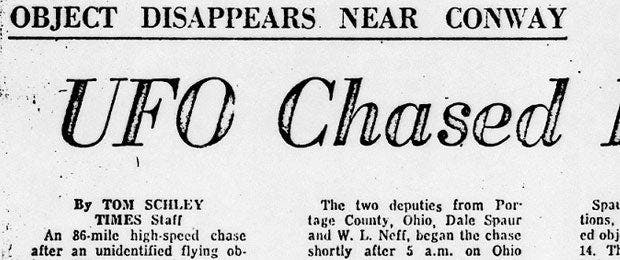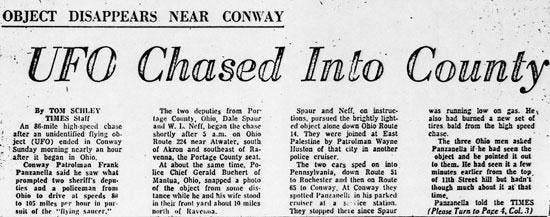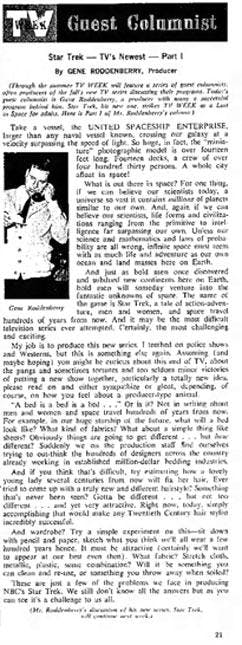Published Jun 28, 2014
Star Trek And Newspapers, Part 1
Star Trek And Newspapers, Part 1

Fans of Star Trek are familiar with the various methods of time travel available in the 23rd and 24th centuries. There is the use of red matter to create a temporal and spatial black hole pulling you into another time, a la Nero and Prime Spock. Or, one could step through the Guardian of Forever and be transported to any time or place. When all else fails, there is always a slingshot around the sun to pick up enough speed for time warp or merely a ride on the coat tails of a Borg sphere.

For you and I stuck in the 21st century, our time travel options are a bit more limited. But we do have one way to travel though time: newspapers. Looking at how and what local newspapers and journalists wrote about Star Trek during the past 50 years is a form of temporal adventure in and of itself. Today, we start a four-part series which will explore the fascinating history of Star Trek as it was covered in newspapers based on four years of archive research we conducted. Along the way, we will share forgotten facts about the origins of Star Trek, the activities of fans during the 1970s, how newspapers treated Star Trek and its fans as this new kind of phenomenon was forming, and some amazing trivia about one of entertainment’s most influential and important franchises
One of the very first mentions of Star Trek in local newspapers was July 8, 1964, in a syndicated column named Tele-Vues by Terry Vernon: “Desilu has made a deal with NBC to coproduce an hour-long science fiction series 'Star Trek,' created by Gene Roddenberry. It would be the first science fiction series with regular characters.” While brief, this mention by Vernon shows from the start that Star Trek was something different than regular television fair or anything that had come before for a weekly show.

Even more important is the mention of Star Trek by Hedda Hopper, a star-making and controversial celebrity journalist and gossip columnist famous for her Hedda Hopper’s Hollywood column starting in the 1930s until her death in 1966. A mention in her column meant that there was buzz about Star Trek in the entertainment world, and her inclusion of it was significant. For her December 4th, 1964 column, Hopper writes about Susan Oliver and her role of Vina. Some of the facts are wrong, especially about Vina being reincarnated as “Earth’s Passion,” but we could forgive Hopper because no one knew what an Orion was in 1964!
By July 1965, newspaper articles had started to appear talking about how NBC had approved another pilot of Star Trek after viewing “The Cage.” Ralf Hardester, an editor with TV Guide Magazine, had a syndicated column named “Today and Tomorrow” and his July 17, 1965 article is one of the first mentions in print of William Shatner taking on the role of the Captain, a full year and almost two months before the show’s actual premiere. The article reveals that “NBC is doing some work on its proposed hour-long science fiction drama, Star Trek, as a possible midseason or ’66-67 entry. William Shatner, of the late For the People, replaces Jeffrey Hunter in the lead…” A fascinating bit of trivia here is that Star Trek, because of its long development period, might have been a midseason replacement show (which is what did occur, of a sorts, for spinoffs Star Trek: Deep Space Nine and Star Trek: Voyager, both premiering in January, although not actually replacing existing programs).

Slightly before the premiere of show, there was a spate of UFO sightings occurring in the United States. Most famously, in April of 1966, police from several jurisdictions chased a UFO for about 30 minutes in Pennsylvania in what was known as the Portage County UFO Chase. The publicity for these and other UFO sightings were receiving wide attention, and few comments in the press appeared joking that it was a publicity stunt for Star Trek. Gene Roddenberry responded to the idea with a humorous quote that appeared during the summer of 1966 in local papers. Roddenberry said: “Somebody up there must like the show.”

In the June 26th article, Roddenberry talks to the readers about what Star Trek is: he uses metaphors to provide a context for the audience. He compares the Enterprise to a naval vessel and a city in space. He also talks about how the premise of the show, the exploration of planets and other civilizations, is rooted in what scientists think about the nature of the universe. Interestingly, he discusses some of the unique problems of producing a show like Star Trek, including having to imagine what futuristic beds and hairstyles might look like.
In TV Week’s introduction to the columns, the editors had written: “Today’s guest columnist is Gene Roddenberry, a producer with many a successful program behind him. Star Trek, his new one, strikes TV Week as a Lost in Space for adults.”
This did not sit well with Gene Roddenberry, who took what he calls “friendly issue” with the description. Immediately after the column ran on June 26th, Roddenberry wrote a letter to the editors, saying that while he appreciated TV Week running his columns, Star Trek was not a Lost in Space for adults or a copy of any other show. Roddenberry writes: “Star Trek is as different from Lost in Space as Gunsmoke is from Lassie.” Of course, to be fair, the editors had only seen the pilot episode of “The Man Trap” when writing their introduction, and the episode did feature the Salt Vampire.
Roddenberry’s second article from July 3rd is prescient, talking about how Star Trek’s technology is rooted in the real world, yet extrapolated to the future. Of course, this is exactly what occurred with everything from cell phones to ion-powered spacecraft being inspired in some way by Star Trek. Roddenberry stresses that Star Trek is about “believability.”
Roddenberry writes in his two part article series that: “The name of the game is Star Trek, a tale of action-adventure, men and women, and space travel hundreds of years from now. And it may be the most difficult television series ever attempted. Certainly, the most challenging and exciting.”
We couldn’t agree more!
NEXT TIME: The amazingly positive response Star Trek got from newspapers after its premiere and some important forgotten history from the making of the show.
SPECIAL THANKS: Thank you to Creation Entertainment for inviting us to share our research findings at official Star Trek conventions this summer and in previous years. These articles emerged as we prepared for these presentations.
Maria Jose and John Tenuto are both sociology professors at the College of Lake County in Grayslake, Illinois, specializing in popular culture and subculture studies. The Tenutos have conducted extensive research on the history of Star Trek, and have presented at venues such as Creation Conventions and the St. Louis Science Center. They have written for the official Star Trek Magazine and their extensive collection of Star Trek items has been featured in SFX Magazine. Their theory about the “20-Year Nostalgia Cycle” and research on Star Trek fans has been featured on WGN News, BBC Radio, and in the documentary The Force Among Us. They recently researched all known paperwork from the making of the classic episode "Space Seed" and are excited to be sharing some previously unreported information about Khan's first adventure with fellow fans. Contact the Tenutos at jtenuto@clcillinois.edu or mjtenuto@clcillinois.edu.

